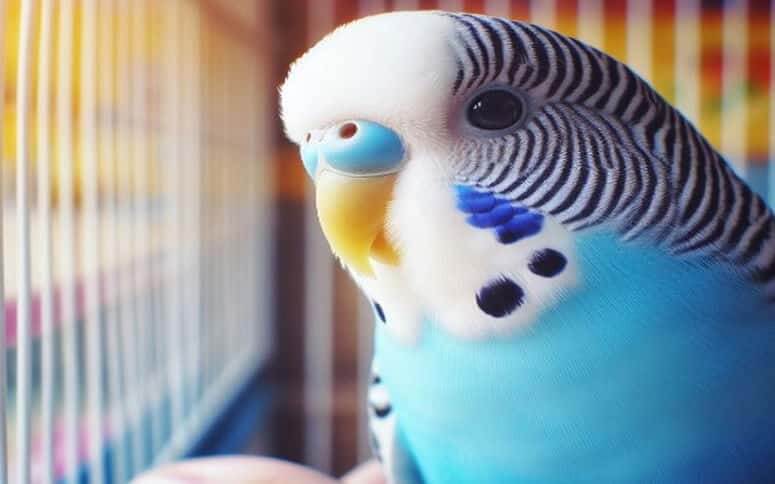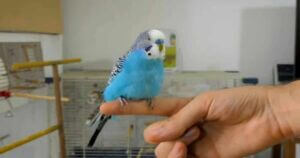What to Do If Budgie Beak Is Too Long?
If your budgie’s beak is too long, it can affect its eating, drinking, and grooming ability. You can try adjusting its diet and environment, but if the beak continues to grow excessively, you may need to trim it, either by yourself or with the help of an avian vet. Regular beak care is essential for your budgie’s health.
As a proud budgie owner and wildlife enthusiast, I know the importance of maintaining a happy, healthy pet. One common problem pet owners face is a budgie’s beak growing too long.
It’s not just a cosmetic issue – it can affect their ability to eat, preen, and even cause serious health problems. In this blog post, I’ll share everything I’ve learned about how to deal with this issue, and why it matters for your budgie’s overall wellbeing.
What Is a Long Beak in Budgies?

A long beak in budgies occurs when the upper or lower beak grows more than it should. Normally, budgies’ beaks are sharp and perfectly sized for eating seeds, fruits, and greens. But, if the beak becomes overgrown, it can interfere with eating, causing discomfort or even pain.
Why Does a Budgie’s Beak Grow Too Long?
There are a few reasons why a budgie’s beak might grow too long:
- Genetics: Some budgies are more prone to beak problems because of their genetic makeup.
- Lack of Proper Diet: If a budgie isn’t eating the right foods or is being fed mainly seeds, they might not wear down their beak naturally.
- Lack of appropriate chewing materials: Budgies need appropriate materials to chew on, such as cuttlebones, mineral blocks, or wooden toys. These help keep their beak trimmed and prevent overgrowth.
- Injury or trauma: Beak overgrowth can also occur due to previous injuries or trauma to the beak. If a budgie’s beak gets fractured or misaligned, it may not wear down correctly.
- Medical conditions: Certain medical conditions, such as liver disease or mites, can lead to beak overgrowth in budgies. It is essential to consult an avian veterinarian if you suspect any underlying health issues.
- Psychological factors: Budgies suffering from stress or boredom may exhibit excessive beak growth due to excessive grooming or chewing behavior.
- Old Age: As budgies age, their beaks can become more difficult to maintain naturally.
How Can You Tell If a Budgie’s Beak Is Too Long?

It’s not always obvious that your budgie’s beak is growing out of control. However, here are a few signs to look out for:
- Difficulty Eating: Your budgie may struggle to eat or drink. They might drop food or have trouble cracking seeds.
- Overgrown Appearance: The beak will start to look more pointed, with the upper and lower parts extending beyond their standard size.
- Damage to the Beak: A budgie’s beak will sometimes develop cracks or chips if it’s overgrown.
- Behavioral Changes: If your budgie avoids food or becomes less active, it could be a sign of pain or discomfort due to its beak.
Can Budgies Eat With An Overgrown Beak?

If a budgie has an overgrown beak, it can face difficulties in eating.
Here are some challenges a budgie with an overgrown beak might face:
| Effects of Overgrown Beak on Budgie’s Eating Habits | Description |
|---|---|
| Difficulty grasping food | Budgie struggles to hold or grasp food properly, leading to dropping or difficulty in gripping food securely. |
| Limited biting and chewing | Budgie finds it hard to bite or chew food effectively, resulting in unprocessed food and difficulties in obtaining essential nutrients. |
| Pain or discomfort | Overgrown beak causes discomfort or pain, discouraging the budgie from eating and potentially resulting in weight loss or malnutrition. |
What To Do If Your Budgie’s Beak Is Too Long?

1. Consult a Vet
The first thing you should do if you notice your budgie’s beak is too long is to consult an avian vet.
They can provide a professional diagnosis and treatment plan. Vets can safely trim the beak to a proper length, preventing further complications.
Pro Tip: If you’re unsure whether your budgie’s beak is overgrown, bring them in for a checkup. It’s better to be safe than sorry.
2. Trim the Beak (Carefully!)
If the vet agrees that trimming is necessary, they will use special tools to trim the beak gently. Never attempt to trim the beak yourself unless you are trained.
Improper trimming can cause serious harm to your budgie, leading to bleeding or permanent damage.
Warning: Some budgies are sensitive to beak trimming. It can be painful for them, so trust your vet to handle the job professionally.
3. Provide a Proper Diet
A balanced diet is crucial for preventing beak overgrowth. If your budgie eats mostly seeds, it might not be getting the right nutrients to maintain a healthy beak. Ensure your budgie’s diet includes:
- Fruits and Vegetables: Carrots, spinach, broccoli, and berries are all great choices.
- High-Quality Pellets: These should make up about 70-80% of your budgie’s daily intake. Pellets are designed to provide all the essential nutrients.
- Chew Toys: Provide toys that encourage your budgie to chew. This helps naturally wear down their beak and keeps it from growing too long.
Fun Fact: Budgies love to chew on cuttlebone and mineral blocks, both of which help maintain beak health.
4. Provide Opportunities for Natural Beak Maintenance
Budgies, like all parrots, need ways to wear down their beaks naturally. In the wild, they do this by foraging, eating tough seeds, and chewing on branches. At home, you can recreate this by providing:
- Perches of Different Sizes: These will help wear down the beak naturally as your budgie climbs and perches.
- Branches from Safe Trees: Budgies love to chew on fresh twigs. Just make sure the branches are pesticide-free.
- Cutting Toys: Give your budgie wooden toys that they can shred and chew.
5. Monitor for Health Issues
Certain health conditions can cause abnormal beak growth. If your budgie is suffering from liver disease, malnutrition, or other internal problems, you need to get them treated as soon as possible. A proper diet, along with regular vet visits, can help prevent these issues from affecting your budgie’s beak.
Important: Beak problems can be a sign of serious health issues. Always keep an eye on your budgie’s overall health and consult a vet if anything seems off.
How Do You Trim a Budgie Bird Beak at Home?
Trimming a budgie’s beak at home requires extreme care and precision. It’s not recommended for everyone, especially if you’re not experienced with handling birds or using grooming tools. However, if you’re confident, here’s how to do it safely.
1. Gather the Necessary Tools
You’ll need the following items:
- Bird-safe nail clippers or a rotary file (available at pet stores).
- Styptic powder (to stop bleeding if you accidentally cut too far).
- A towel to restrain the bird safely.
- Bright lighting for clear visibility.
2. Prepare Your Budgie
- Find a quiet, stress-free environment to work in.
- Wrap your budgie gently in a soft towel, exposing only its head. This prevents sudden flapping and reduces stress.
- Have someone assist you if possible, especially when holding the bird while you trim.
3. Examine the Beak
- Look closely at the beak under good lighting.
- The beak’s tip often has a translucent area. This is where the overgrowth starts.
- Avoid trimming too close to the base, where blood vessels and nerves are located.
4. Trim Gradually
- Use the clippers to snip small amounts from the overgrown portion of the beak.
- Work slowly and check your progress after each cut.
- For a smoother finish, use a fine emery board or rotary tool to file down rough edges.
5. Check for Bleeding
- If you accidentally cut too far and there’s bleeding, apply styptic powder immediately to stop it. Never panic—calmly handle the situation to keep your bird from becoming frightened.
When to Avoid DIY Beak Trimming
- If your budgie is unusually squirmy or nervous.
- If the beak is severely overgrown or deformed.
- If you lack experience or confidence in handling birds safely.
In these cases, visit an avian vet. It’s always better to be safe than risk hurting your budgie.
Beak Overgrowth in Budgies: Common Questions
1. How often should I check my budgie’s beak?
It’s a good idea to check your budgie’s beak regularly, at least once a month. If you notice any changes in their eating habits or the appearance of their beak, consult a vet immediately.
2. What are the signs that my budgie’s beak needs trimming?
If you notice that your budgie is struggling to eat, or if their beak looks longer than usual, it’s time to seek help. A long beak can cause pain and difficulty eating.
3. Can a long beak cause health problems?
Yes. If a budgie’s beak is too long, it can affect their ability to eat, drink, and preen, leading to malnutrition and other health issues.
Preventing Long Beaks in Budgies

It’s always better to prevent problems than to fix them. Here are some tips to keep your budgie’s beak healthy:
- Provide a Balanced Diet: Feed your budgie a variety of fruits, vegetables, and pellets. Avoid over-relying on seeds.
- Offer Chew Toys: Keep your budgie entertained and active with toys that promote natural beak wear.
- Regular Vet Check-ups: Keep an eye on your budgie’s health with regular check-ups from an avian vet. They can spot early signs of problems, including beak growth issues.
Reminder: A healthy budgie is a happy budgie. Regular maintenance and good care can prevent serious problems down the road.
Wrapping On What to Do If Budgie Beak Is Too Long
A long beak in budgies can lead to serious health problems if left untreated. By consulting an avian vet, offering a proper diet, and providing opportunities for natural beak maintenance, you can help your budgie stay healthy and happy. Be proactive, and your budgie will thrive for years to come.
Please share this post with other budgie lovers. The more people who know about caring for their feathered friends, the better.
Read More:
- Why Does My Budgie Have A Crusty Cere?
- How to Care for a Starved Budgie?
- Why Do Budgies Puff Up?
- Do Budgies Get Cold at Night?
- 9 Common Mistakes That Shorten A Budgie’s Life
Hello Dear, I'm Poli Kolymnia, owner of many birds (including budgies).
With a deep passion for these feathered companions, I'm here to share my expertise and extensive knowledge on birds care.
My articles cover essential topics like diet, housing, care, and health, providing practical tips to help you create a happy and thriving environment for your birds.







